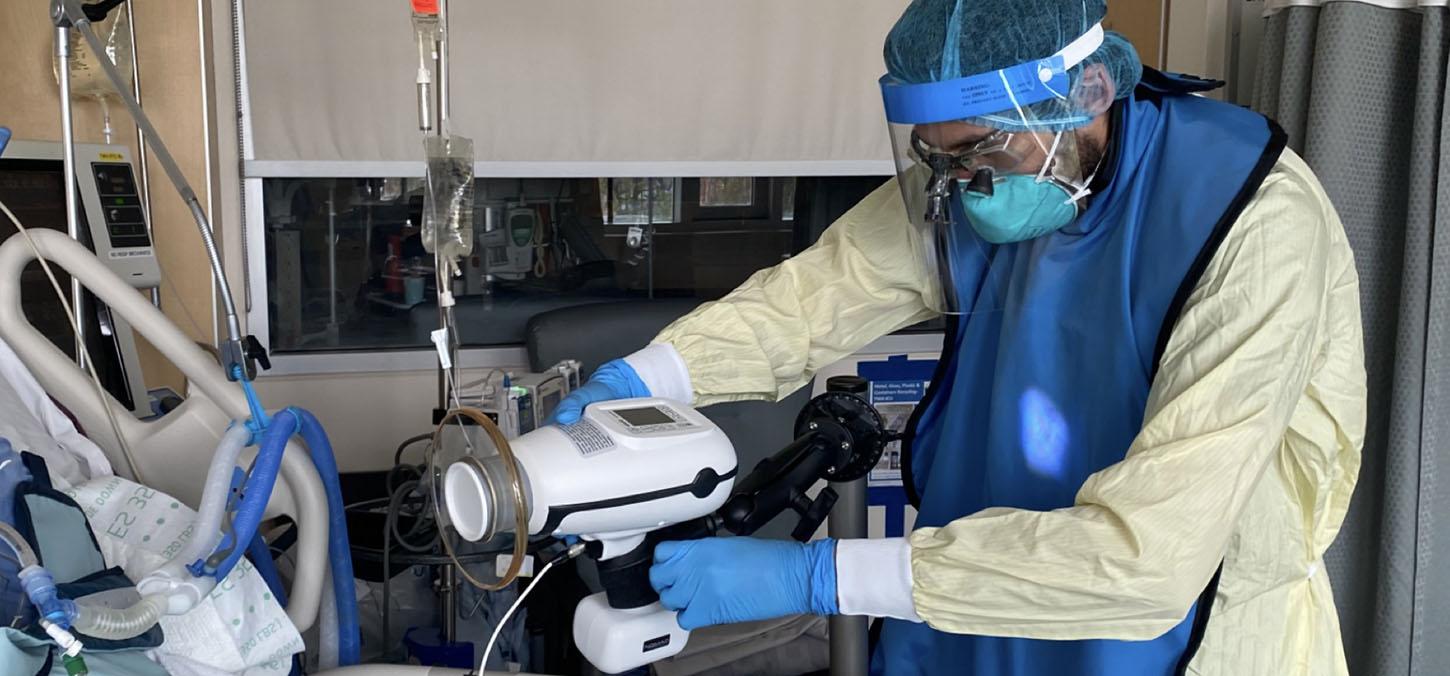
Portable Dental Radiograph Helps ICU Patients
By Diane Peters
In early May, Toronto Western ICU staff called in the University Health Network (UHN) Dental Team led by Faculty of Dentistry professor Michael Glogauer. They had a patient in his sixties with COVID-19 who risked aspirating a loose bridge and teeth.
Glogauer, 9T3, 9T9 Dip Perio, 9T9 PhD, who is dentist-in chief at UHN, and his team started their assessment with a device that’s brand new to hospitals in Canada: a portable dental radiograph unit.
“Our Dental Fellow Dr. Amr El Maghrabi and I were able to properly assess him right then and there,” recalls Glogauer. Normally, dentists in hospitals who treat patients in their beds don’t have access to dental radiographs. “We’d have to go in to urgent clinical situations and do exams, diagnosis and treatment, without having dental radiographs,” says Glogauer. “The standard of care in dentistry is to have a radiograph. We were treating patients with one hand tied behind our backs.”
Thanks to this newly approved device, the team was able to see exactly what was going on before they removed the bridge and a few teeth, right in the ICU.
“It was amazing to finally have access to this technology, it made our task safer and much more efficient,” says Glogauer of the device.
Glogauer helped get the unit approved in Canada and into UHN for use in its downtown Toronto hospitals — a process that took two years. “The regulatory hurdles have been incredibly challenging,” he says.
Dentists in hospital settings seeing critically ill patients who can’t be moved to the dental clinics, often work in very challenging conditions. While some patients can visit the dental services clinics, many are too sick or connected to life-saving devices that prevent them from leaving their beds. As a result, dentists often end up operating right in the wards, bringing in their own equipment and creating a mini-dental environment in the moment.
Glogauer says he has been concerned about lack of bedside radiographs in hospitals for years. He began his advocacy by speaking to the manufacturer of a device being used in the US, encouraging the company to expedite the Health Canada approval. There were barriers: because the device uses radiation the Canadian regulators required the user to be two metres away from the device. The company had to invent a tripod to allow it to be triggered at a distance.
“The company had to be willing to devise this trigger,” says Glogauer. “That is likely a tough decision when they didn’t even know how big the Canadian market would be.” In general, companies shy away from seeking Health Canada approval on many drugs and devices because the market is so small here.
The KaVo NOMAD Pro 2 got regulatory approval in November 2019. After that, Glogauer and Dr. Gaurav Krishnamoorthy, the Oral and Maxillofacial Radiologist at UHN, along with the UHN Manager of Medical Imaging, worked with the Ontario government to get the green light at the provincial level too.
But even then, who would help pay for the device? Glogauer approached Dr. Heather Ross, head of cardiology for UHN, and she agreed to find the funds. Especially since heart patients often need dental work done in their rooms before they can safely have their heart surgeries.
COVID-19 has helped Glogauer make his case over the last year, as many patients with the respiratory disease are low-income people who have underlying health conditions, including untreated dental conditions.
“Poor oral health certainly is apparent in some of the COVID patients we have seen,” says Glogauer. Intubation can disturb teeth and become a risk to their already compromised breathing.
Since the device arrived in early May, Glogauer and his team have been able to use it across UHN. It packs up in its own bag and is now part of the portable surgical kit the team uses to perform dental surgery wherever they are needed.
Glogauer says the dental team do about five on-unit procedures every month, and the portable radiograph will aid those procedures in running as efficiently and safely as possible. He thinks the team will need this tool more in the coming months.
“As surgeries ramp up, we’re going to be called in more often,” he says. While the hospital attempts to clear backlogs, Glogauer expects to be treating some very sick patients right in their beds.
While UHN is the first in Canada to purchase and use this unit, it may soon find itself in other urgent care settings. With dental radiographs the standard of care before any surgical dental procedure, having access to this machine allows hospital dentists to do the best they can in often very challenging treatment situations.
Photo: Michael Glogauer uses the Portable Dental Radiograph (Provided by Michael Glogauer)